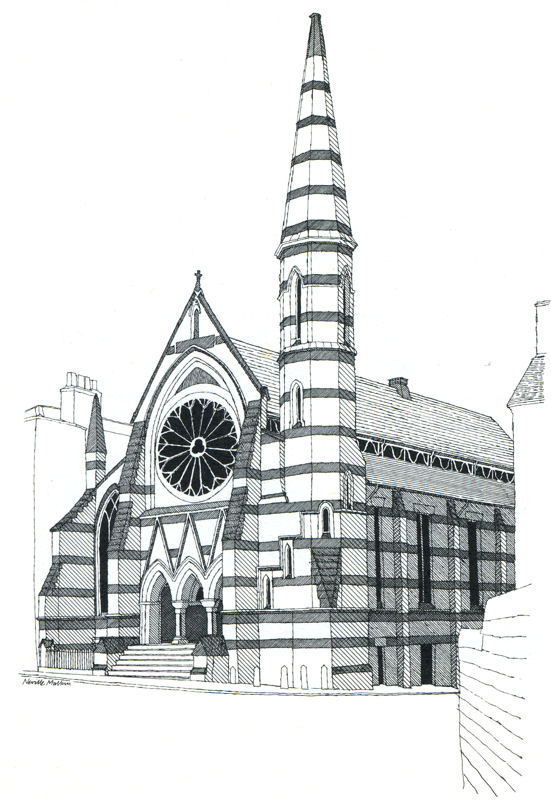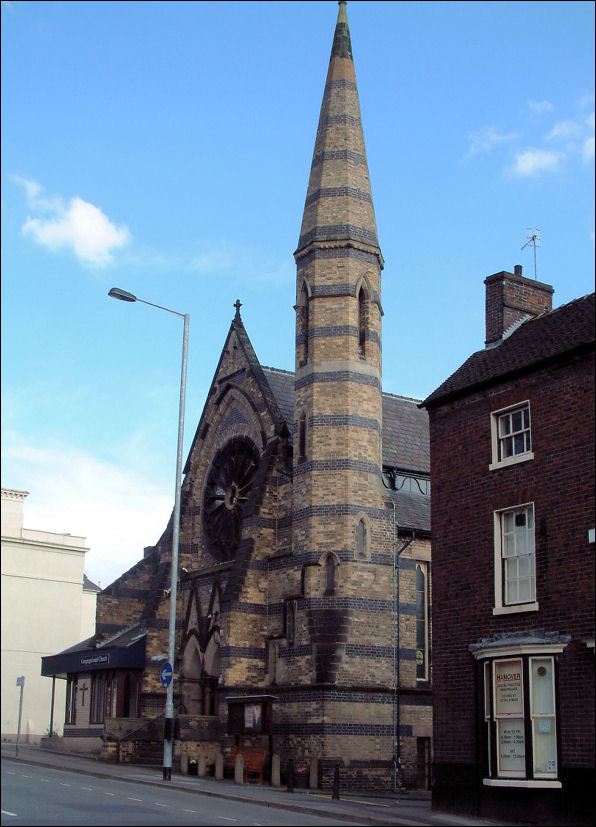|
|
|
![]() back to "The Grand Tour" index
back to "The Grand Tour" index
Neville Malkin's "Grand Tour" of the Potteries
buildings in and around Newcastle-under-Lyme
![]()
![]()
![]()
next: The Museum,
Newcastle-under-Lyme
previous: The Bulls Head,
Newcastle
contents: index of buildings in and around Newcastle-under-Lyme
|
No 25 - Congregational
Church, Newcastle
|

Congregational Church,
Newcastle-under-Lyme
pen drawing by Neville Malkin - Sept 1975

Congregational Church,
King Street,
Newcastle - April 2009
|
"This interesting example of evangelistic extravagance is the Congregational Church in King Street, Newcastle. It is built from yellow brick, with regular layers of blue, and various stone embellishments. Among its main features are a pleasant wheel window, a three arched entrance, various buttresses, and a prominent octagonal tower. I find it an exciting piece of Mid-Victorian eccentricity and a very welcome relief from current monotony. Congregationalism was originally a form of church government adopted by Protestants who chose to manage their own affairs. In 1672 a Declaration of Indulgence allowed dissenters to hold services in houses that were registered for worship, and in Newcastle the Congregationalists joined with the Presbyterians in establishing ministerial training. In the 1770s, Captain Jonathan Scott injected new life into Newcastle's movement. His popularity continued to grow in North Staffordshire and South Cheshire, and he attracted many benefactors. One such patron was Lady Glenorchy whose support enabled him to run an academy in Newcastle between 1783 and 1792. During this period the movement founded one of the first Sunday schools in the county. In 1784 his congregation built the Marsh Chapel which was replaced by the present Congregational Church in 1859." Neville Malkin 10th Sept 1975
|
|
A group of Christians began to meet in
Newcastle in 1776 under the leadership of a Cavalry Officer, Captain
Jonathan Scott. He married a pious society woman of wealth, Elizabeth
Cley, of Shropshire and with her resources, and those of Lady Glenorchy
of Scotland, he worked to found several independent congregations in
Staffordshire, including one at Newcastle. Our baptism register goes
back to 1777, and the Church was formed by a 'covenant' or solemn
agreement, in 1782.
A brick building was erected on the
present site, and it was known as the Marsh Chapel, because of the
nature of the ground. In 1859 that was replaced by the present
structure, which has been described as 'an architectural eccentricity'.
It is, however, full of charm and is 'listed' for its special qualities.
In recent years a great deal of work has been carried out to give it a
new roof, a special entrance for the handicapped, and a much improved
lower hall.
|
next: The Museum, Newcastle-under-Lyme
previous: The Bulls Head, Newcastle
contents: index of buildings in and around Newcastle-under-Lyme
back to "The Grand Tour" index